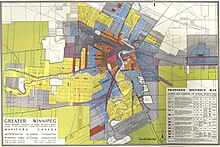User:DJsametz/sandbox

Euclidean zoning has been the dominating system of zoning in much of North America since its first implementation[1]. The resulting divided land use patterns generated by the Euclidean system have been charged by many commentators as having played a direct role in a number of problems in land use planning evident in the United States and elsewhere.
Problems affiliated with Euclidean-style zoning policy include suburban sprawl, urban decay, environmental pollution, racial and socioeconomic segregation, negative economic impacts and an overall reduced quality of life.[2][3] Land use regulations associated with a high separation of land uses have also been criticized as being fraught with legal obstacles to rehabilitating neighborhoods affected by the aforementioned problems [2] (such efforts are often referred to under the banner of urban rehabilitation or urban renewal).
Euclidean zoning represents a functionalist way of thinking that uses mechanistic principles to conceive of the city as a fixed machine. This conceptions is in opposition to the view of the city as a continually evolving organism or living system, as first espoused by the German urbanist Hans Reichow.
Planning and community activist Jane Jacobs wrote extensively on the connections between Euclidean-style zoning and the destruction and displacement of communities in New York City. Her work details how conventional zoning often leads to the decay of municipal infrastructure and social capital and perpetuates brutal cycles of poverty and chronic under-funding in certain neighborhoods.[4] Jacob's writings, along with increasing public dissatisfaction with the attendant problems of urban sprawl, is often credited with inspiring the New Urbanism movement and the enusing body of literature concenred with solutions to uneven city development.
 | This is a user sandbox of DJsametz. You can use it for testing or practicing edits. This is not the sandbox where you should draft your assigned article for a dashboard.wikiedu.org course. To find the right sandbox for your assignment, visit your Dashboard course page and follow the Sandbox Draft link for your assigned article in the My Articles section. |
- ^ in 1916 New York became the first became the first city of implement this type of zoning law, later upheld in Village of Euclid v. Ambler Realty Co., 272 U.S. 365 (1926). “Operating from the premise that everything has its place, [Euclidean] zoning is the comprehensive division of a city into different use zones.” JULIAN CONRAD JUERGENSMEYER & THOMAS E. ROBERTS, LAND USE PLANNING AND DEVELOPMENT REGULATION LAW § 4.2, at 80 (1998) (cited in BLACK’S LAW DICTIONARY under Euclidean zoning.
- ^ a b Hall, E. (2006). Divide and sprawl, decline and fall: A comparative critique of Euclidean zoning. U. Pitt. L. Rev., 68, 915.
- ^ Jay Wickersham, Jane Jacob’s Critique of Zoning: From Euclid to Portland and Beyond, 28 B.C. ENVTL. AFF. L. REV. 547, 557 (2001).
- ^ Jacobs, Jane. The Life and Death of Great American Cities. Vintage.
